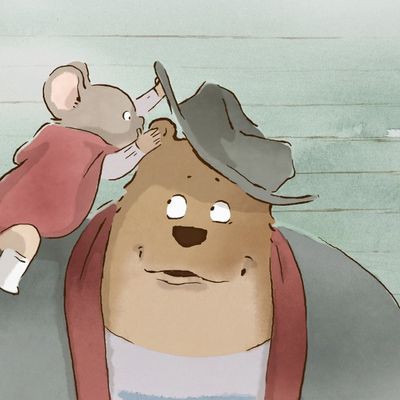
Ernest and Celestine, which was nominated for a Best Animated Feature Oscar this year, is a profoundly civilized film. Gently parodic and full of visual whimsy, this French-Belgian animation about the friendship between a mouse and a bear has a simple story that even the youngest viewers could understand, yet it also possesses a refined, almost melancholy sense of goodness. It has things to say about the world, but it does so gracefully, without hitting you over the head with them.
The film opens on young mouse Celestine, up late one night at her orphanage, drawing a bear and a mouse, and being informed by her fellow orphans that “a bear and a mouse cannot be friends.” Sure enough, in walks the Gray One, the headmistress, to read the mice a bedtime story about the monstrousness of bears; as she lists all the ways that a bear might eat a mouse (“Baked, roasted, and skewered! Sauteed, deep fried … even raw!”), the candlelight casts terrifying shadows on the walls. Celestine, possessing the soul of an artist, remains unconvinced: After the Gray One is done, she adds smiles to the bear and the mouse she was drawing earlier.
Meanwhile, somewhere in the woods, we find Ernest, an impoverished artist bear living in a rundown shack surrounded by instruments, besieged by a hole in his roof that lets in snow. Ernest plays music in the street for his food. One day, he finds Celestine in a garbage can, and attempts to eat her. After that initial hump, they get over their culturally mandated fear of one another and find a way to work together. Ernest is hungry, and Celestine needs some teeth. You see, the mice live underground and come out at night to take the teeth of young bear cubs; they’re tooth fairies with tails. Then, the mice dentists use those teeth to replace the decaying incisors of their fellow rodents — because without teeth, a mouse is useless. Celestine helps Ernest break into a candy shop; in return, Ernest helps Celestine bust into the tooth store across the street. (Yes, the bears have tooth stores.)
Based on the popular children’s books by Gabriel Vincent and lovingly animated by hand, Ernest and Celestine offers up a purposefully surreal universe. Consider the way these two societies are presented: The mice live in a highly regimented, subterranean world where their whole culture revolves around the procurement of teeth and the terror of bears. The bears, on the other hand, live in a decadent, free-market world where their opportunities seem limitless — if they’re not poor like Ernest, that is. But they, too, are in a few unforgiving cycles of their own. At one point, a well-to-do family of bears sits around their dining table in their extravagant home and mull how dad owns the aforementioned candy shop and mom owns the tooth store: One rots the teeth, while the other replaces them, all at a cost. One society is remorselessly transactional, while the other is Spartan and intolerant; each exploits the other, even as they hover suspended in a kind of Cold War. And Ernest and Celestine, the two artists — one a child imagining a world full of possibility, the other a bitter, impoverished busker who lives like a hermit, far from his civilization — say phooey to all that.
Don’t let the above fool you into thinking the film is bluntly didactic, however. Rather, like all good children’s films, Ernest and Celestine couches its particular obsessions in a broader message of acceptance and tolerance, one woven into its central tale of friendship. But it has an edge, too. On the occasions it goes dark, the film is downright chilling: Celestine at one point has a nightmare about drowning in a sea made of mice, and I haven’t been able to shake that image from my mind. But still, the film’s gentleness persists. Ernest and Celestine is a modest, beautiful little children’s fable with a wise, grown-up heart.


